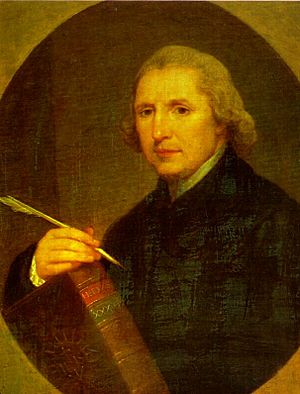Lorenzo Hervás facts for kids

Lorenzo Hervás y Panduro (born May 1, 1735, in Horcajo, Spain; died August 24, 1809, in Rome, Italy) was a Spanish Jesuit priest and a very important philologist. A philologist is someone who studies languages and their history.
He was one of the most important thinkers of the Spanish Universalist School of the 18th century. This group of scholars aimed to gather and share knowledge from all over the world.
Contents
His Life Story
Lorenzo Hervás joined the Jesuit order in Madrid. He studied at Alcalá de Henares, where he focused on architecture and linguistics. Linguistics is the scientific study of language.
For a while, he taught at a royal school in Madrid and a Jesuit college in Murcia. Later, he traveled to the Americas as a missionary. He stayed there until 1767. At that time, the Jesuit order was abolished, meaning their schools and missions were taken away.
Return to Europe
Hervás then returned to Europe. He lived first in Cesena, Italy, and later moved to Rome in 1784. In 1799, he went back to Spain, his home country. However, after four years, he returned to Rome and lived there for the rest of his life.
He was highly respected in Rome. Pope Pius VII made him the head of the Quirinal library. He was also a member of several important academic groups.
Studying Languages
In Italy, Hervás met many Jesuits who had come from all over the world. This was a great chance for him to learn about many different and unknown languages. He studied languages that could not be learned from books alone.
He wrote down what he learned in many books. First, he wrote them in Italian, and then they were translated into Spanish.
His Important Works
Hervás's biggest work was a huge book series called "Idea dell' Universo" (Idea of the Universe). It was published in Cesena between 1778 and 1787 and had 21 volumes. Many parts of this work were translated into Spanish and published as separate books.
Catalog of Languages
The most important part of his "Idea of the Universe" was published separately in Italian in 1784. Its Spanish title was "Catálogo de las lenguas de las naciones conocidas" (Catalog of the languages of the known nations). This book came out in Madrid between 1800 and 1805, with six volumes.
In this catalog, Hervás tried to find out where different nations came from and how they were related. He did this by studying their languages. The main goal was not just about words, but about understanding human history through language.
- Volume I covered languages from the Americas.
- Volume II looked at languages from islands in the Indian and Pacific Oceans.
- The other volumes focused on European languages.
Hervás did a good job describing and classifying American languages. He also showed that Malay and Polynesian languages belonged to the same language family. He believed that understanding a language's grammar was more important than just looking at similar words to find connections between languages. Even with some mistakes, his work was very helpful for later language researchers.
Other Writings
Hervás wrote other parts of his "Idea of the Universe" that were also published separately. These included:
- "Virilità dell' Uomo" (Manhood of Men) (4 volumes, 1779–80)
- "Vecchiaja e morte dell' Uomo" (Old age and death of Man) (1780)
- "Viaggio estatico al Mondo planetario" (Ecstatic Journey around the World) (1780)
- "Storia della Terra" (The History of Earth) (1781–83, 6 volumes)
- "Origine, formazione, mecanismo ed armonia degl' idiomi" (Origin, formation, mechanics and harmony of Languages) (1785)
- "Vocabolario, Poliglotto, con prolegomeni sopra più de CL lingue" (Vocabulary, Multilingualism, with introduction to more than 150 languages) (1787)
- "Saggio practicco delle Lingue con prolegomeni e una raccolta di orazioni dominicali in più di trecento lingue e dialetti" (Wise Language practice with introduction and a collection of dominical prayers in more than three hundred languages and dialects) (1787)
Hervás also wrote books to help deaf people learn. His most famous one was "La Escuela Española de Sordo-mudos ó Arte para enseñarles á escribir y hablar el idioma español" (The Spanish School of Art for Deaf-mutes, or the Art of teaching to write and speak the Spanish language) (Madrid, 1795). He also wrote about other topics, like "Descripción de los archivos de la corona de Aragón y Barcelona" (Description of the records of the kings of Aragon and Barcelona) (Cartagena, 1801).
He left many writings that were never published, such as a "History of Writing" and a "Universal Paleography" (the study of old writing).
Linguistics Discoveries
Lorenzo Hervás y Panduro identified several "language families" (groups of languages that come from a common ancestor). Some of these include:
- Tupí, Guaraní, Homagua [Omagua-Campeva], and “Brasile volgare” (Tupí-Guaraní languages)
- Guaicurú [Kadiweu], Abipón, and Mocobí (Guaicuruan languages)
- Lule and Vilela (Lule-Vilelan languages)
- Maipure and Moxa [Moxo] (Arawakan languages)
See also
 In Spanish: Lorenzo Hervás para niños
In Spanish: Lorenzo Hervás para niños

